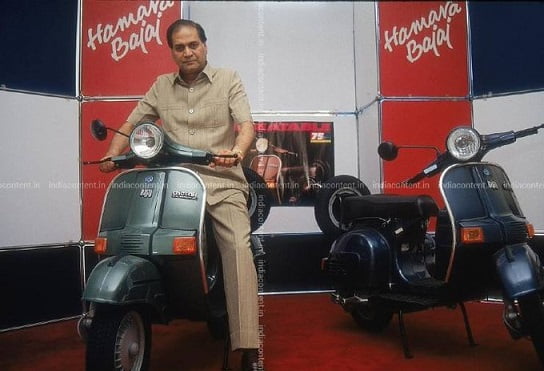Rahul Bajaj: Fearless, Outspoken & The ‘Hamara Bajaj’ Man

“Yeh zameen
Yeh asmaan
Hamara kal
Hamara aaj
Buland Bharat
Ki Buland Tasveer
Hamara Bajaj
Hamara Bajaj”
Mumbai: For a generation of Indians, the name ‘Bajaj’ was synonymous with scooters — Bajaj 150, Bajaj Super, Bajaj Chetak…
During the seventies, eighties and nineties, entire families — father, mother and two children — travelled on Bajaj scooters, to the market for shopping, to restaurants for dining, to picnic spots and to the theatre. Young boys and girls learnt how to ride two-wheelers on Bajaj scooters.
It was the nation’s favourite scooter.
‘Hamara Bajaj’.
The entire nation on Saturday mourned the passing away of eminent industrialist Rahul Bajaj, former Chairman of Bajaj Group, who turned the humble Bajaj scooter into ‘Hamara Bajaj’, the scooter of choice for millions of middle-class Indians. Maharashtra Chief Minister Uddhav Thackeray said that Bajaj will be cremated with full state honours.
When the ad campaign was launched in 1989, it touched the nation’s heart.
Bajaj was still the market leader among scooters but the economy was slowly opening up and it faced competition from new models. Indian manufacturers like LML and Kinetic were tying up with Vespa and Honda to roll out scooters that looked contemporary and sleek. The two-wheeler market was also moving towards bikes with Indian manufacturers tying up with Honda, Yamaha and Suzuki. Bajaj itself had tied up with Kawasaki to manufacture bikes.
Bajaj — the only truly Indian brand, sturdy, solid and still the most popular scooter — lacked the sleekness of its competitors.
But the ‘Hamara Bajaj’ campaign didn’t talk about sleekness, speed, fuel efficiency, engineering specs and foreign technology to beat competition. Instead, it focused on the fact that Bajaj was proud to be an Indian brand and the scooter was an integral part of every family occasion and memories.
Unconventional and risky, Rahul Bajaj went ahead, and the half-minute ads stole the nation’s heart.
Bajaj was known for his plainspeak and fearless nature.
In the seventies, he began manufacturing Bajaj Chetak and Super on his own after Italy’s Piaggio didn’t renew Bajaj’s licence.
Before economic liberalisation, under the ‘Licence Raj’, there used to be a waiting time of years to own a scooter. Bajaj protested this and said that he didn’t mind going to jail to manufacture a commodity most Indians needed.
In recent years, he remarked that there was an atmosphere of fear in the country and people were afraid to criticise the government.
Last year, addressing shareholders for the last time as the Chairman of Bajaj Auto, he warned that any more lockdowns may not necessarily check the spread of COVID-19 but will definitely hit businesses, employment and cripple the economy.
“Let us hope that rapidly accelerated vaccinations coupled with a strict enforcement of masks and social distancing will soon bring the second wave under control. Let us also hope that we do not react to the epidemic by declaring more lockdowns, as we did the last time. For these will destroy business, employment and the economy without necessarily controlling the spread of the disease,” he had said.
Bajaj was born on June 30, 1938 in Kolkata. His grandfather Jamnalal Bajaj founded the Bajaj Group in 1926 and his father Kamalnayan Bajaj succeeded him in 1942.
The industrialist graduated from St Stephen’s College in Delhi in 1958 and also earned a law degree from Bombay University. He did his MBA from Harvard Business School and became Bajaj Auto CEO in 1968.
He was appointed the chairman of erstwhile Indian Airlines in 1986 and was conferred the Padma Bhushan in 2001. In 2006, he was elected to the Rajya Sabha.
Also read: https://odishabytes.com/industrialist-rahul-bajaj-passes-away/

Comments are closed.